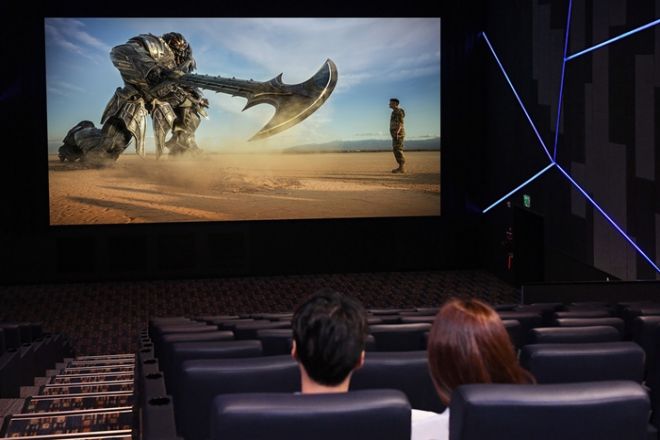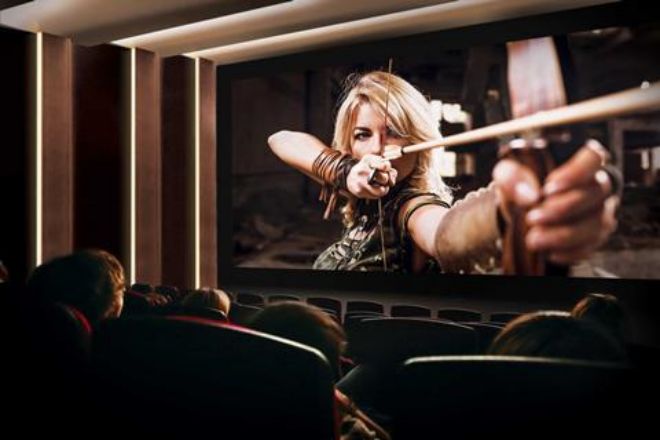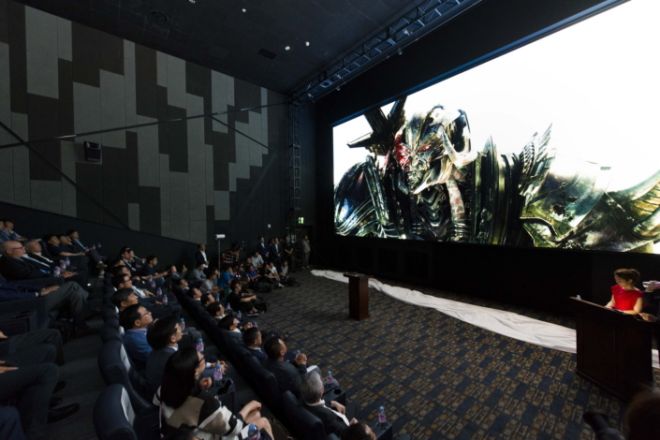介绍

随着科技的飞速发展和人们生活品质的不断提高,电影院作为文化娱乐的重要场所,也在不断寻求创新与突破。作为现代显示技术的引领者, LED显示屏 凭借高清晰度、高亮度、高可靠性等特点,LED显示屏在影院中得到了广泛的应用,然而LED显示屏的潜力远不止于此。
1、LED显示屏在电影院的传统应用
- 电影放映
LED显示屏以其高清、高亮度的特点,给观众带来前所未有的观影体验。在电影院中,LED显示屏取代传统放映设备,直接显示电影画面,不仅色彩更鲜艳、细节更清晰,而且亮度更高,即使在较明亮的放映室中也能保持画面清晰可见。让观众更加沉浸在电影世界中,享受更逼真的观影体验。
- 广告
在电影院大厅、走廊等区域,LED显示屏已经成为重要的广告宣传工具,电影院可以利用LED显示屏播放电影预告片、广告信息、活动通知等内容,吸引观众的注意力,提高电影的热度和票房。
同时,LED屏的灵活性和多样性也让广告内容更加丰富多彩,可根据不同的节日、主题、影片类型进行定制。
- 观众指南
LED屏幕在电影院中还扮演着观众引导的角色,通过在大厅、走廊等区域设置LED屏幕,电影院可以实时显示各个放映厅的座位情况、电影放映时间、卫生间位置等信息,帮助观众快速找到自己的座位和所需设施。
这不仅提高了观众的观影效率也提高了电影院的服务水平。
2、影院LED屏的新使用场景

1). 互动体验区
互动游戏:在影院内设置专门的互动体验区,利用LED屏幕展示互动游戏,观众可通过触摸屏、体感设备等方式参与游戏,与屏幕上的内容进行互动,增加观众在影院的娱乐体验。
电影知识展示:在互动体验区,LED屏幕可以显示电影的相关知识、幕后花絮等,通过观看这些内容,观众可以深入了解电影的背景和制作流程,增加对电影的兴趣和好奇心。
2). 虚拟影院体验
沉浸式观影:利用LED屏幕与虚拟现实(VR)技术,打造沉浸式观影体验,观众可佩戴VR设备,通过LED显示屏呈现的影像进入虚拟电影世界,体验身临其境的观影效果。
角色互动:在虚拟影院中,观众可以与电影中的角色进行互动,通过手势识别、语音交互等技术,观众可以与屏幕上的角色进行对话、完成任务等,增加了观影的趣味性和互动性。
3). 社交分享区
拍照留念:在影院内设置专门的拍照留念区,以LED显示屏作为背景或道具,观众可以在观影前后在LED显示屏前拍照留念,并通过社交媒体分享给朋友和粉丝。
观众留言:设置观众留言区,供观众在LED显示屏上留下观影感受、评论等,通过实时更新留言内容,让观众感受到彼此之间的交流与互动,增加观影的社交性。
4).主题活动展示
节日主题:针对不同的节日(如万圣节、圣诞节等),电影院可以利用LED显示屏显示与节日相关的主题内容。通过营造节日气氛,吸引观众参与节日活动,增加电影院的节日氛围和吸引力。
电影主题:针对不同类型的电影(如科幻、恐怖、动画片等),电影院可以设置相应的LED屏幕显示内容。通过显示与电影主题相关的图片、视频等,增强观众的参与感和沉浸感,提高观影体验。
5). 实时新闻资讯播报
新闻资讯:电影开播前或开播后,利用LED屏幕播放实时新闻、电影行业动态等资讯,不仅为观众提供最新资讯,也增加了影院的文化氛围和观众的知识储备。
活动通知:同时LED屏还可以用来播放电影院最新的活动通知、优惠信息等,及时更新内容,引导观众参与电影院各项活动,提高电影院的知名度和吸引力。
3、LED屏新使用场景对影院的影响
- 改善观众体验
LED屏幕的全新使用场景为影院带来了前所未有的观众体验,通过引入互动游戏、虚拟影院体验等多样化的娱乐形式,影院不再仅仅提供观影服务,而是成为集娱乐、社交、学习等功能于一体的综合场所。
这种多样化的服务延长了观众在影院的停留时间,增加了观众对影院的满意度和忠诚度。
- 增加观众粘性
新的使用场景通过提供丰富的互动体验,让观众与影院的联系更加紧密。
在参与互动游戏、体验虚拟影院的过程中,观众不仅享受到了乐趣,也加深了对影院和电影内容的理解,这种深度的参与和体验让观众对影院产生了更强的归属感,从而增加了再次光顾影院的意愿。
- 扩大收入来源
新的使用场景为影院带来了新的盈利点。首先,通过对互动游戏、虚拟影院体验等服务收费,影院可以直接增加收入。其次,这些新的使用场景也能吸引更多观众到影院,从而带动电影票房和爆米花等零食的销售。
此外,影院还可以利用LED屏进行广告合作,为品牌提供广告展示的机会,从而进一步扩大营收来源。这些新的盈利点不仅有助于提升影院的盈利能力,也为影院的长期发展提供了稳定的资金支持。
4.LED屏新使用场景的挑战与应对措施

1). 技术挑战
如何保证LED屏在不同使用场景下的稳定性、可靠性,特别是面对高强度的使用、长时间的运行,以及复杂的交互需求。
1.1). 应对措施:
选用优质的LED显示屏,保证其具有优良的散热性能、耐用性、稳定性。
引入高刷新率、广色域等先进显示技术,满足不同使用场景的视觉需求。
定期对LED显示屏进行维护和保养,及时发现和解决潜在问题,保证设备长期稳定运行。
2). 内容挑战
如何制作出符合影院环境、电影主题的优质内容,吸引观众,提升观众的参与度和兴趣。
2.1). 应对措施:
与专业的内容制作公司合作,共同开发针对不同使用场景的内容,保证内容的多样性和趣味性。
定期更新展示内容,根据电影上映、节庆活动等因素进行调整,保持内容的新鲜感和吸引力。
鼓励观众参与内容创作,如设置观众留言区、征集观众建议等,增加内容的互动性和参与度。
3). 运营挑战
如何有效管理和运营新的使用场景,保障各个环节的顺畅运行,同时提升观众的满意度和体验度。
3.1). 应对措施:
建立完善的运营体系,明确各个环节的职责和流程,保证运营的高效性和规范性。
培训专业操作人员,提高其专业素质和服务水平,确保能应对各种突发事件和问题。
引入先进的运营管理系统,如数据分析、用户反馈等,及时收集、分析运营数据,为运营决策提供支持。
加强与观众的沟通互动,了解观众的需求和反馈,不断改进和优化运营策略。
结论
LED显示屏在影院新使用场景的探索,不仅给观众带来了前所未有的观影体验,也为影院行业带来了新的发展机遇。
通过不断的技术创新和应用探索,我们有理由相信,未来的电影院将更加多元化、智能化,成为人们休闲娱乐的好去处。
最后,如果你想了解更多关于LED显示屏的信息, 请与我们联系。
